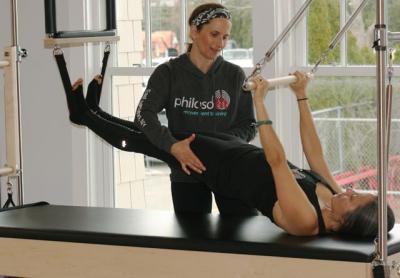Philosofit Extends Its Reach
Source: The East Hampton Star
Ari Weller’s philosofit studio in East Hampton, which for the past five years has been strengthening and lengthening the muscles of its clients through stability stretching and GYROTONIC® exercises, recently leased a well-lit upstairs studio on Lumber Lane in which Susan Moran Sheehy, who has overseen the certification of 12,000 Pilates teachers worldwide, has been giving classes for the past month.
Overseen by Susan Moran Sheehy, Marie Weller arched into the breathing exercise on a Pilates “Cadillac” apparatus at Philosofit Saturday afternoon. Photo by Jack Graves.
During a conversation the other day, the two agreed that combining GYROTONIC® (which Weller and others of his instructors have been teaching) with Pilates was serendipitous.
“It’s always been my vision to join the two methods of movement,” he said, “and when it came to Pilates I wanted the best of the best, which Susan is. I studied Pilates with her 20 years ago, in the city. She used to own Power Pilates in Chelsea and was Pilates’s largest global educator. So, when I saw on Facebook a few months ago that she’d moved to Long Island [Smithtown], I jumped at the chance.”
Sheehy, who was a dancer — she still is, though no longer a professional — first encountered Joseph Pilates’s exercises when she was a student at the State University at Purchase.
“That’s where I met Romana Kryza-nowska, who was a protégée of his. I started with her when I was 18 and I’ve never stopped. Pilates changed my body from the inside out. I became a happier person with a stronger body. I was able to dance at a much higher level . . . ballet, modern, you name it.”
For a decade she toured the world with the Doug Elkins Dance Company, teaching Pilates, “a universal language,” wherever the company went.
“Everyone who does it becomes happier, stronger, and more flexible,” said Sheehy, a professed “lover of movement,” whether it be dance, swimming, yoga, skiing, or walking. “I believe movement is medicine, that energy creates energy. For instance, you may be having a rough day, but you can be energized by the person next to you in a mat class.”
There are a number of apparatuses in philosofit’s upstairs studio, including the disciplines’ hallmarks, the Pilates “reformer,” a sliding, spring-loaded mat that can, according to Sheehy, be “supportive or challenging depending on how many springs you use,” and GYROTONIC’S® crab-like tower-pulley assembly that enables one, in Weller’s words, to “work the body in multiple planes of motion . . . in circles, and undulations.”
“You could say GYROTONIC®, which Julio Horvath, a dancer and yogi, who was also influenced by yoga, swimming, dance, and tai chi, invented, is yoga on a machine. It may sound silly, but that’s what it is. Just as Pilates, as Susan said, works from the abdominals out, Gyrotonic works from the spine out.”
“You not only need to be flexible and strong,” Weller continued, “but you need to be flexible and strong equally. Over the years Horvath has developed these machines to help with the movements, providing more range of motion, more resistance, and more mobility.”
“The layman’s definition for Pilates is ‘abdominals and . . .’ ” Sheehy said. “Because you work your whole body starting from your abdominals. The abdominals first, then the abdominals and the legs, the abdominals and the hands, the abdominals and the arms, and the abdominals and the back. You work from your core out . . . it’s a whole body workout.”
“We’ll be getting more machines,” said Weller. “By next week we should be the largest GYROTONIC®studio, as far as I know.”
For the curious, philosofit is offering introductory packages that can be put toward group classes in Pilates, GYROTONIC®, and GYROTONIC® (the mat version of GYROTONIC®).
While the aims of Pilates and GYROTONIC® were essentially the same, resulting in a more balanced body (and mind), it came down to which method one preferred, said Weller. “You feel different after running or cycling or swimming. You feel it in your legs after cycling, more or less all over after running, and in your upper body after swimming. But they’re all cardiovascular workouts.”

